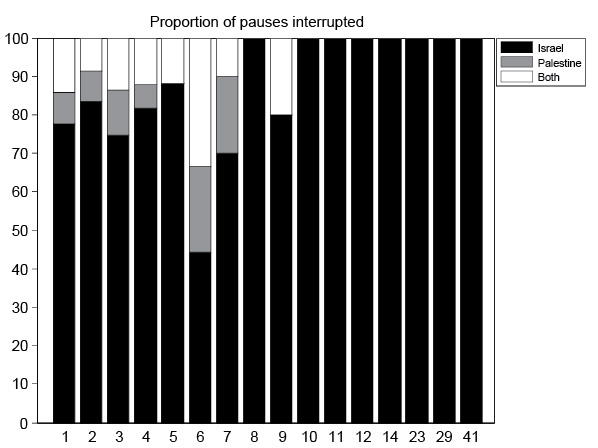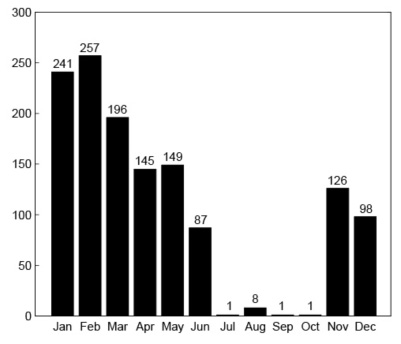You Started It First! No You Did!
Well, actually, in 79% of cases, Israel did.

Here is a remarkable piece of statistical analysis by Nancy Kanwisher, Johannes Haushofer, & Anat Biletzki in the Huffington Post.
The graph above sums it all up. Analyzing data from September 2000 through October 2008, they looked at all "pauses in conflict": defined as 1 day or more with no one killed on either side of the Israel/Palestine conflict. Then they looked at who killed first, to break the pause. These killings are the "pause breakers." (Killings that took place within 24 hours of a previous killing where ignored.)
The pause breakers where grouped by how long the preceding pause in the killing had lasted. That's what is shown on the horizontal axis. The left most column represents all pauses that where at least one day, but less than 2 days (the next column to the right). Similarly the second column from the right represents all pauses that lasted at least 29 days, but less than 41 days (the right most column). And the right most column represents the all pauses that lasted 41 days or more.
The vertical axis shows the percentage of "pause breaking" killings that where commited by each side. Black represents Israelis, grey Palesineans, and white represented pause breaks where both sides committed a killing on the same day.
Israel committed the first killing in 79% of the cases over all. Whats more, the longer the pause, in killing, the more likely that the first killing to break the pause would be committed by the Israelis.
... of the 25 periods of nonviolence lasting longer than a week, Israel unilaterally interrupted 24, or 96%, and it unilaterally interrupted 100% of the 14 periods of nonviolence lasting longer than 9 days.

The current round of violence, is no exception. After several months quiet on the Gaza front, (see graph to the right, showing Hamas rocket launches per month) and of zero killings in Gaza by Israelis or in Israel by Gazans, the first killing in or around the Gaza Israel border occurred on November 4 2008, when the Israeli army killed a Palestinian armed man inside Gaza.
According to the Guardian of November 5:
And so it began. Again.A four-month ceasefire between Israel and Palestinian militants in Gaza was in jeopardy today after Israeli troops killed six Hamas gunmen in a raid into the territory.
Hamas responded by firing a wave of rockets into southern Israel, although no one was injured. The violence represented the most serious break in a ceasefire agreed in mid-June, yet both sides suggested they wanted to return to atmosphere of calm.
Israeli troops crossed into the Gaza Strip late last night near the town of Deir al-Balah. The Israeli military said the target of the raid was a tunnel that they said Hamas was planning to use to capture Israeli soldiers positioned on the border fence 250m away. Four Israeli soldiers were injured in the operation, two moderately and two lightly, the military said.
One Hamas gunman was killed and Palestinians launched a volley of mortars at the Israeli military. An Israeli air strike then killed five more Hamas fighters. In response, Hamas launched 35 rockets into southern Israel, one reaching the city of Ashkelon.
Why did Israel do it? Why is Israel usually the one to strike first? Is it a doctrine of preventive war at play here (ala George Bush 2,) and then it becomes a self fulfilling prophecy? Or is it a doctrine of "overwhelming force" (ala George Bush 1) that fails to succeed in overwhelming, but does succeed in eliciting a more the violent response from the other side? Or is it just an attempt to "teach them a lesson", but with a very poor pedagogy. (One might recall that the second intifada started when Israelis shot and killed 18 Palestinian demonstrators/rioters - over a three day period - before the first Israeli was killed by a Palestinian.)
Unfortunately Israeli's possess a destructive combination of exaggerated fear, a trigger happy leadership, and an effective military.
What would happen if they restrained themselves, and waited for the other side to strike first? The graph above suggests that at the very least there would be longer periods of peace. And who knows, if they got long enough, that might become become habit forming. Maybe Israel should try that next time.


0 Comments:
Post a Comment
<< Home